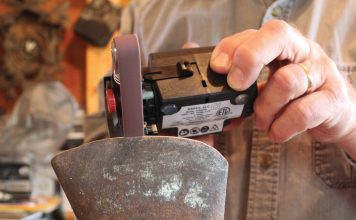 |
|
| Issue #89 • September/October, 2004 |
This article is the third in a series of our beginner’s course in solar electricity. Simultaneously we have instituted a Home Energy Information (www.homeenergy.info) section on our website where you can ask questions of Jeff Yago, the author of this series. Yago is a licensed professional engineer and certified energy manager who has written many energy articles for BHM. He has extensive solar thermal and solar photovoltaic system design experience, and is author of Achieving Energy Independence One Step At A Time, which includes many solar system wiring examples.
This third installment of our continuing course on solar electric power system basics will address power inverters. Since all solar photovoltaic modules generate DC electricity, unless all of the lights and appliances being powered are DC, an alternative energy power system will need to include an inverter. This device is used to convert the DC electricity from the solar modules and batteries into AC electricity.
Inverter basics
|
Early inverters for the consumer market were used mainly for mobile applications like boats and recreation vehicles, and most were designed for 12-volt DC battery ignition systems. Due to an upper capacity limit of approximately 200 amps for the internal power components and heavy welding cables that were being used for connecting these mobile 12-volt systems, 2,400 watts was about the largest capacity inverter that could be made for these applications (12V x 200A = 2,400 W). To keep inverter costs low and the designs simple, these early inverters generated a “modified” sine wave output to simulate the 60-cycle 120-volt AC line voltage. The more “steps” in the modified waveform, the closer the output voltage will be to a normal AC sine wave.
Until the explosive increase in personal computers and microprocessor controlled appliances and audio/video equipment, most electrical loads that included older technology would work fairly well on a modified sine wave inverter. Incandescent lights and power tools also worked well, although some fluorescent fixtures and light dimmers had problems. An AM radio may produce an objectionable hum in the background, and a microwave oven will take much longer than normal to cook the same food, but most of these devices would still operate on a modified sine wave inverter.
In the early 1990s, quality modified sine wave inverters were being sold by Trace Engineering and Heart Interface. Although still limited to about 2500-watt output using a 12-volt DC input, these became the standard for residential off-grid and back-up power systems. Many of these early models are still in operation and have an excellent reputation for robust design and reliability.
By the mid-90s, lower costs for solar photovoltaic modules and the need to power more sophisticated appliances, computers, and digital audio/video systems created a demand for larger inverter capacities and a smoother 60-cycle voltage waveform. Manufacturers responded with inverter outputs up to 5,500-watts by using higher voltage 24 to 48-volt DC inputs and more sophisticated internal electronics to increase the number of “steps” simulating the 60-cycle sine wave.
Some newer inverter models include a communications “link,” which allows interconnecting multiple inverters to provide synchronized higher wattage and voltage outputs. Since these changes resulted in much higher inverter prices, most manufacturers still offer lower cost modified sine wave models when lower capacity and power quality are not a concern.
The Trace (now Xantrex) SW series 3,600, 4,000 and 5,500-watt inverters and the Outback FX 2000 and 2,500-watt inverters are currently the most popular residential inverters for back-up and off-grid power systems, although there are several other excellent brands just now entering the market. As long as it includes a battery powered inverter, any alternative energy system can continue to power the lights and appliances directly from the batteries after the sun goes down, the wind stops blowing, or the generator is turned off.
Grid-tie systems
As the price of solar photovoltaic modules continues to fall and the price of peak afternoon electricity continues to increase, it is becoming cost-effective in some states to install solar modules just to reduce daytime metered electricity usage and sell any excess power
|
generated back to the utility. Since these systems are not intended to provide emergency power, a grid-tie inverter can be less expensive since there are no battery chargers, battery bank, or costly high amperage components to buy. Obviously, if these special application inverters require the utility grid to serve as their “battery,” a grid-tie solar system without a battery bank cannot serve as a source for emergency or back-up power. Increasing the voltage for a given wattage allows reducing the current (watts = volts x amps). Since these inverters are designed for much higher DC solar array voltages than low voltage battery based systems, this can substantially reduce solar array wire size and wiring costs. However, with grid-tie solar array wiring in the 300 to 400-volt DC range, the potential for shock or fire causing arcing is substantially increased over a 12 to 48-volt DC battery based system. All roof mounted solar photovoltaic arrays must be protected by DC ground fault circuit breakers.
In recent years there have been several American made grid-tie inverters that did not meet promised efficiency performance, and several grid-tie inverter manufacturers have gone out of business which created a shortage in the American grid-tie inverter market. As a result, several European manufacturers moved in and filled this market niche with inverters that had excellent product quality and provided high operating efficiencies. The “Sunny Boy” line from Germany and the more recent Fronius line from Austria are becoming major contenders for this domestic grid-tie inverter market.
Inverter features
Not all inverters are created equal, and there are more differences and options to pick from than just having to decide between a modified sine wave and a pure sine wave unit. Since this may be the most expensive component in your alternative energy system, there is a tendency to under-size the inverter just to save a few dollars. Don’t fall into this trap, as you can always install fewer solar modules now and add more later, to save some up-front costs.
|
Many models of inverters are available with a built-in load transfer relay. This transfer relay is useful for back-up emergency power applications. Unlike a straight DC to AC inverter, an “AC input” connection is provided to connect the inverter to a spare circuit breaker in the main house panel. The AC output connections on the inverter are then connected to a new subpanel that will supply all critical loads in the house. This usually includes some of the lighting circuits, kitchen appliance outlets, refrigerator, and audio/video center. Although a well pump would be considered a critical load, most inverters have a 120-volt AC output and most well pumps are 220-volt. This will require either buying two matching inverters or using a step-up transformer. As long as utility power reaches the inverter’s AC input side, the transfer relay will continue to pass this AC grid power directly through the inverter to the sub-panel’s critical loads.
Any interruption in utility grid power results in the transfer relay automatically switching to the battery powered inverter output so the subpanel’s loads will now be supplied from the battery bank. Although these inverters are not advertised as suitable as a computer UPS power supply, I have found that the relay transfer time is fast enough to not affect most computers.
Inverters that include the AC input terminals and transfer relay may also include a built-in battery charger. This circuit monitors the battery state of charge and will keep the battery fully charged when utility grid power is available and the transfer relay is switched to grid power. A word of caution is in order however. Most inverter battery chargers are very heavy-duty and charging outputs over 100 amps are not uncommon. Special care must be taken to insure all of the battery charging setpoints are correct on the inverter for the size and type of batteries being used, or this high capacity charger could easily damage a very expensive battery bank.
|
Some inverters are available with a separate generator start relay. This is a real necessity for back-up and off-grid applications. These inverters may also include a second AC input specifically for generator power. This generator start option allows programming the generator to either start as soon as the utility grid fails, or start when a low battery charge level has been reached. Since the inverter is only operating the generator to recharge the batteries, the generator will operate fewer hours than a straight generator-only power system. In an application using a large solar array, there will be one or more separate charge controllers feeding DC charging current directly into the battery bank, in addition to this grid or generator powered charging by the inverter.
When using these more sophisticated battery-charging inverters with a solar array, you must take care to properly balance the battery charging setpoints on the inverter with the setpoints on the solar charge controllers. If not set correctly, the inverter will easily “over-power” the output from the solar array and provide all of the battery charging from the utility grid regardless of the available sunlight. Some of the more expensive sine wave inverters are very versatile and provide many different system and battery charging setpoints for system fine-tuning. However, this versatility also requires more knowledge to properly set up a system to maximize its performance. Although these inverters may work right “out of the box,” this does not mean the default settings are right for your specific application. If this appears to be too much of a challenge, you may want to consider a less sophisticated inverter model or hire a professional solar installer.
Almost all inverter manufacturers offer a remote display panel option. From a basic on/off switch to a more sophisticated data display screen, these are really useful if your inverter and battery bank are located in a hard to access crawl space or garage. I like to locate these remote displays in the kitchen where most people pass through several times each day, which allows a quick check on system status.
|
Some inverters include a separate unused control relay that can be programmed by the installer to switch almost anything. For example, a battery room exhaust fan could be turned on by this relay when the battery voltage reaches a high limit during heavy charging and out-gassing begins. An alarm bell or light could be activated by this relay when a low battery charge is reached to tell the occupants to reduce their electrical usage or to start a manually operated generator.
Please note that not all inverters have these features, so if they are important to your application, be sure to shop carefully. Something to consider when shopping for an inverter is the balance of system (BOS) components you will also need, as these are not normally included in the advertised inverter base price.
For example, the list price for an Outback FX Series 2500-watt inverter is $1,995; however, this does not include the optional (but almost always needed) DC cover for $65, the DC end conduit adapter for $45, the AC end adapter for $35, or DC circuit breaker disconnect enclosure for $519.
The same is also true for the Trace (Xantrex) 3,600-watt SW Plus Series inverter with a list price of $2,800. This price does not include the optional (but almost always needed) DC conduit box for $90, the AC conduit box for $369, or the generator start module option for $159.
|
In addition, the inverter list price for any battery-powered inverter almost never include the required battery hook-up cables, which can run as high as $200 for a 10-foot pair.
A grid-tie inverter purchase is usually more straightforward, since you will not need heavy battery cables, batteries, or large DC disconnects. A 2500-watt SMA Sunny Boy grid-tie inverter has a list price of $2,845. Since this includes a cover with digital display and built-in ground fault circuit breakers for multiple solar array inputs, the only other electrical component you will need is a $5 circuit breaker to feed the new inverter AC output to your existing main house circuit breaker panel.
Inverter shopping tips
1. If you are on a tight budget or are building a remote cabin system that will only need RV or boat-type 12-volt DC lights and appliances, you still may need to power a limited number of small AC appliances. Consider the 1500-watt StatPower (now Xantrex) low cost modified sine wave inverter designed for mobile applications. This is about the smallest size inverter that can still power a power saw, refrigerator, or microwave oven. Although these are normally 12-volt input inverters, they are available in many different outputs. For a slightly higher price, the Heart Interface (also now Xantrex) 2500-watt RV and marine line of modified sine wave inverters have higher capacities and more features.
Most lower cost inverters are fairly reliable, but they do not have the same robust overload and control features that are found on more expensive models. An accidental system overload when starting a well pump or clothes washer may result in inverter or battery damage when using lower priced and lower wattage models.
|
2. If you just want to reduce your utility bill and do not need to power lights and appliances after the sun goes down or during a power outage, then your solar power system may not need a battery bank. This will allow using the lower cost “grid-tie” inverter models such as Sunny Boy, Sharp, StarInverter, or Fronius. This will also allow using a much higher voltage solar array, which can reduce solar array wire size and associated installation costs.
3. If you plan to install a system that will have a battery bank, and your loads will include more power sensitive computer and digital audio/video equipment, you will probably want to consider one or more Trace (Xantrex) or Outback sine wave inverters powered from a 24 or 48-volt DC battery bank.
4. Wind turbines can quickly recharge a battery bank during unusually high wind conditions. Shutting off a wind driven generator as soon as the batteries are charged can cause over-speed of the now free turning blades. To avoid blade damage, many wind power systems include a “diversion load” control. This allows automatically switching the power output from battery charging to a second load such as electric heating elements in a hot water tank. This provides free water heating while keeping the wind generator under a constant load. There are several new grid-tie inverters just entering the market specifically designed for wind generator type power output.
(Photos of inverter installations are courtesy of Dunimis Technology Inc. and Energy Outfitters Inc.)
5. Using a small-scale (under 25-kW) grid-tie inverter to sell power back to the utility is a fairly new concept, and many states and electric utilities require an exterior safety disconnect and a utility inspection process before you can do this legally. Many utilities may also want you to install a special electric meter that totals electric flow in both directions. Be sure to check with your local utility before installing any solar system that will be used to sell electricity back to the utility, as some state regulations are very strict.
The next installment in this series of articles will address solar array basics and solar battery charging techniques.
[weaver_widget_area id=’articles_about_yago’ class=’text3′]






















